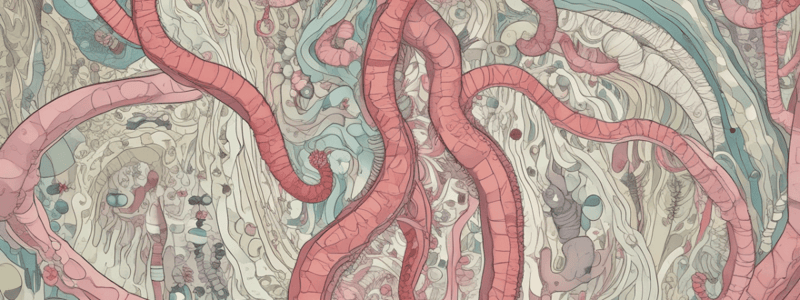Podcast
Questions and Answers
What connects amino acids in a protein?
What connects amino acids in a protein?
- Peptide bond (correct)
- Covalent bond
- Ionic bond
- Hydrogen bond
Which of the following defines a disaccharide?
Which of the following defines a disaccharide?
- A complex protein
- Two simple sugars linked together (correct)
- Multiple sugar units
- A single sugar
What are the three major components of a nucleotide?
What are the three major components of a nucleotide?
- Simple sugars, polysaccharides, lipids
- Amino acids, peptides, fats
- Triglycerol, fatty acids, glucose
- Phosphate group, ribose sugar, nitrogenous base (correct)
What type of molecule primarily consists of glycerol and fatty acids?
What type of molecule primarily consists of glycerol and fatty acids?
What is the sugar component called in nucleic acids?
What is the sugar component called in nucleic acids?
Which of the following is a basic sugar unit?
Which of the following is a basic sugar unit?
How many fatty acid tails are present in a triglyceride?
How many fatty acid tails are present in a triglyceride?
What is the process called that breaks down macromolecules for absorption?
What is the process called that breaks down macromolecules for absorption?
What is the role of peptidases in protein digestion?
What is the role of peptidases in protein digestion?
What must happen to trypsinogen before it can function as an enzyme?
What must happen to trypsinogen before it can function as an enzyme?
Which enzyme is responsible for breaking down lactose in carbohydrates?
Which enzyme is responsible for breaking down lactose in carbohydrates?
What can result from the loss of lactase due to inflammation in the duodenum?
What can result from the loss of lactase due to inflammation in the duodenum?
Which type of bond does amylase help to break down?
Which type of bond does amylase help to break down?
Nucleosidases are specifically responsible for breaking which type of bond?
Nucleosidases are specifically responsible for breaking which type of bond?
What is the main function of bile secreted by the liver and gall bladder in digestion?
What is the main function of bile secreted by the liver and gall bladder in digestion?
After carbohydrate digestion, the basic unit that is primarily absorbed is called?
After carbohydrate digestion, the basic unit that is primarily absorbed is called?
What happens to chymotrypsinogen before it can effectively break peptide bonds?
What happens to chymotrypsinogen before it can effectively break peptide bonds?
Which of the following enzymes is involved in breaking down glycosidic bonds?
Which of the following enzymes is involved in breaking down glycosidic bonds?
Flashcards are hidden until you start studying
Study Notes
Digestion Process and Macromolecules
- Digestion involves breaking down four major macromolecules: proteins, carbohydrates, nucleotides, and fats.
Proteins
- Comprised of chains of amino acids linked by peptide bonds.
- Enzymes called peptidases, present at the brush border of the intestines, break peptide bonds.
- The pancreas secretes inactive forms of enzymes: trypsinogen and chymotrypsinogen, which require activation.
- Enteropeptidase, from the brush border, activates trypsin and chymotrypsin, allowing them to further digest proteins into amino acids for absorption.
Carbohydrates
- Made of repeating units of simple sugars.
- Single sugars are monosaccharides, two are disaccharides (e.g., lactose), and multiple sugars are polysaccharides.
- Amylase secreted by the pancreas helps break glycosidic bonds in carbohydrates.
- Brush border enzymes, such as lactase, are specific for breaking down disaccharides like lactose.
- Lactose intolerance can occur temporarily when inflamed duodenum walls reduce lactase production.
Nucleotides
- Form nucleic acids like DNA and consist of a phosphate group, ribose sugar, and a nitrogenous base (e.g., adenine, guanine).
- Nucleosidases at the brush border isolate the base from the nucleoside by cleaving bonds, leaving the ribose sugar attached to a phosphate group.
Fats
- Composed of a glycerol head attached to three fatty acids.
- Bile from the liver and gall bladder emulsifies fats, aiding in their breakdown.
- Lipase, produced by the pancreas, breaks down fats by cleaving fatty acids from the triglyceride, leaving distinct fatty acid chains.
Studying That Suits You
Use AI to generate personalized quizzes and flashcards to suit your learning preferences.




